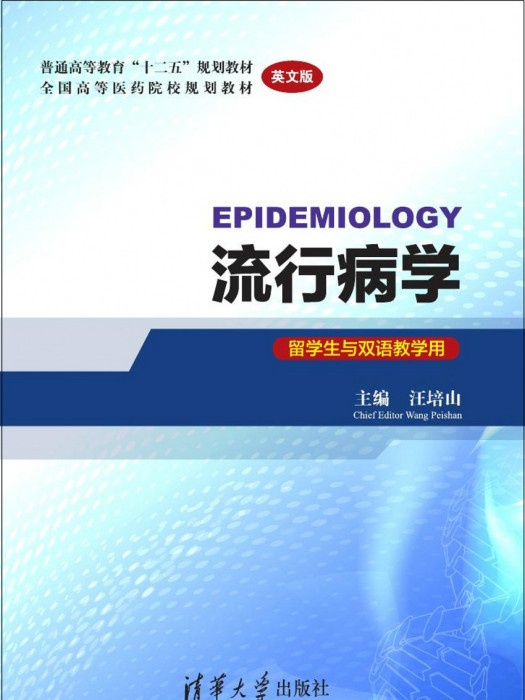《流行病學(留學生與雙語教學用)(英文版)》是2014年清華大學出版社出版的圖書,作者是汪培山。
基本介紹
- 中文名:流行病學(留學生與雙語教學用)(英文版)
- 作者:汪培山
- 出版社:清華大學出版社
- 出版時間:2014年11月25日
- 定價:49.8 元
- ISBN:9787302375111

流行病學(2014年清華大學出版社出版的圖書)一般指本詞條
《流行病學(留學生與雙語教學用)(英文版)》是2014年清華大學出版社出版的圖書,作者是汪培山。
流行病學(epidemiology)是研究特定人群中疾病、健康狀況的分布及其決定因素,並研究防制疾病及促進健康的策略和措施的科學。是預防醫學的一個重要組成部分,是預防醫學的基礎。流行病學是人們在不斷地同危害人類健康嚴重的...
流行病指可以感染眾多人口的傳染病。流行病可以只是在某地區發生,亦可以是全球性的大流行。歐洲語言中,辭源均來自希臘語,如英語的epidemic,法語的épidémie等。當某一疾病之觀察值超過預期值時,就稱之為流行。而全球流行其定義為某一疾病之傳染已經跨過洲與洲的界限時稱之。原理與原則 某種傳染病的連續出現是否...
流行病學 流行病學課程是由為葉冬青課程負責人,為安徽醫科大學主要建設單位的國家級一流本科課程。教師團隊 課程負責人:葉冬青 授課教師:蘇虹、潘海峰、楊林勝、張志華 所獲榮譽 2020年11月24日,該課程被中華人民共和國教育部認定為“首批國家級一流本科課程”。
《流行病學(案例版,第2版)》是由羅家洪、李健主編,科學出版社於2018年1月出版的中國科學院教材建設專家委員會規劃教材、全國高等醫藥院校規劃教材。該教材適用於醫學生全國統考、畢業後執業醫師考試和碩士研究生入學考試,也可作為在職醫療衛生人員繼續教育培訓教材,還可以作為在職醫療衛生人員科研參考書。全書共20章...
《流行病學》是2016年中國醫藥科技出版社出版的圖書。內容簡介 本書是全國普通高等醫學院校五年制臨床醫學專業“十三五”規劃教材規劃教材之一,根據本學科教學大綱的基本要求和課程特點編寫而成,本書具有以強化醫學生職業道德、醫學人文素養教育和臨床實踐能力培養為核心,推進醫學基礎課程與臨床課程相結合,轉變重理論而輕...
《流行病學》是2017年人民衛生出版社出版的圖書。內容簡介 《流行病學(第8版 供預防醫學類專業用)/全國高等學校教材》共分26章,其中第1~11章為總論,系統介紹流行病學的基本概念、原理和方法;第12~19章為分支小總論,包括傳染病流行病學、慢性病流行病學、傷害流行病學、突發公共衛生事件流行病學、精神...
理論流行病學是一種醫學術語,廣泛套用於流行病學研究的各個領域 概念 理論流行病學(theoretical epidemiology)又稱流行病學數學模型(mathematical model),它使用數學公式明確地和定量地表達病因、宿主和環境之間構成的疾病流行規律,同時從理論上探討不同防制措施的效應。套用 流行病學數學模型廣泛套用於流行病學研究...
《流行病學(供預防醫學專業用)》是2006年人民衛生出版社出版的圖書,作者是王建華。內容簡介 全書共23章,分總論、各論兩部分,以國內外最新材料為主介紹了流行病學的基本理論、研究範圍及思維方法,併兼顧我國當前有重大公共衛生意義的疾病。目錄 第一章 緒論 第二章 病因與病因推斷 第三章 疾病的分布 第四...
傳染病流行病學(infectious disease epidemiology)主要研究傳染病在人群中發生、流行過程及影響過程的因素,並制定預防、控制和消滅傳染病的對策與措施。傳染病流行簡史 1.古代人類與傳染病鬥爭的歷史:據考古學研究結果,大約1萬年到1萬1千年以前,就有傳染病流行。公元846年,在入侵法國的諾曼人中暴發天花。公元1555...
《流行病學(第一卷第3版)》是2015年人民衛生出版社出版的圖書,作者是李立明、王建華。內容簡介 第2版第一卷共29章,本次再版,原第3、21、22章有關傳染病和非傳染病小總論的內容分別歸至第二、三卷,原第25、26章關於程式計算器和計算機的套用的內容顯然已經過時,原第13、14、28、29章關於移民流行病學...
《流行病學》是2018年人民衛生出版社出版的圖書。內容簡介 《流行病學/全國高等學校教材》內部各環節合理設定,根據讀者對象的特點,在英文原版教材的基礎上結合需要,增加本章小結、關鍵術語(英中對照)、思考題、推薦閱讀等模組,促進學生自主學習。圖書目錄 1 Introduction to Epidemiology PATIENTS PROFILE INTRODUCTION...
全書共20章,8個實例(實習指導)和5個附表,1999年中國醫藥科技出版社出版的書籍,作者李學信主編 內容簡介 本書詳細介紹了流行病學的基本理論、基本知識和基本技能以及在疾病防制中的套用。全書共20章,8個實例(實習指導)和5個附表,供大學專科和成人高等醫學院校各不同專業的流行病學教學使用,同時可作為高、...
環境醫學的一個分支學科。它套用流行病學的理論和方法,研究環境中自然因素和污染因素危害人群健康的流行研究規律,尤其是研究環境因素和人體健康之間的相關關係和因果關係,即闡明暴露-效應關係,又稱接觸-效應關係,以便為制定環境衛生標準和採取預防措施提供依據。 環境流行病學起源於對自然因素引起的疾病的研究,如地方...
《流行病學第七版》,2008年6月人民衛生出版社出版的圖書,作者是王建華。本書進一步貫徹“三基”、“五性”的基本要求,突出重點,抓住關鍵,樹立精品意識。對於經典的流行病學方法,注意吸納新的成熟的進展,緊密結合,臨床實踐,敘述深入淺出。本書特別指出分析流行病學純屬沒有明確界定的一個模糊概念,國際流行病學界...
《流行病學(修訂)》是2008年1月東南大學出版社出版的圖書。作者是陸召軍,莊勛。本書主要介紹流行病學概論、預防分布及病因研究;流行病學基本研究方法;傳染病流行病學、疾病預防和監測、醫院感染;流行病學各論,包括心臟血管疾病、惡性腫瘤、性傳播疾病以及分子、遺傳、傷害流行病學等。內容簡介 本書為《流行病...
《流行病學(案例版,第2版)》是2009年科學出版社出版的圖書,作者是姚應水、高曉虹。內容簡介 為順應教育部教學改革潮流和改進現有的教學模式,適應目前高等醫學院校的教育現狀,提高醫學教學質量,培養具有創新精神和創新能力的醫學人才,科學出版社在充分調研的基礎上,引進國外先進的教學模式,獨創案例與教學內容相...
《流行病學(留學生與雙語教學用)(英文版)》是2014年清華大學出版社出版的圖書,作者是汪培山。內容簡介 本教材系統地介紹了流行病學的基本原理和方法,內容簡明易懂,每章後面附有重要專業辭彙和部分練習題,適合初學流行病學的臨床醫學專業的留學生和本科生雙語教學作為入門教材,也可以作為其他醫學相關專業,如...
《流行病學(第二卷)》是2015年由人民衛生出版社出版的圖書,作者是曹務春。內容簡介 本卷共152章,涉及的內容基本涵蓋了當前主要的傳染病。本卷按照傳染病的傳播方式和流行特徵將傳染病劃分為六大類,包括消化道傳染病、呼吸道傳染病、經血和性傳播傳染病、自然疫源性與蟲媒傳染病、體表接觸傳播傳染病和寄生蟲病...
實驗流行病學亦稱干預研究,是指以人群為研究對象,以醫院、社區、工廠、學校等現場為“實驗室”的實驗性研究。實驗流行病學研究是流行病學研究的主要方法之一。概念 實驗流行病學(experimental epidemiology)研究是指以人群為研究對象,以醫院、社區、工廠、學校等現場為“實驗室”的實驗性研究。因為在研究中施加了...
血清流行病學是用血清學方法和技術進行流行病學研究的方法,於1916年創立。學科簡介 血清流行病學(Seroepidemiology)是流行病學的一個重要分支,它是用血清學方法和技術,分析研究人群血清中特異性抗原或抗體的分布規律及其影響因素,以闡明傳染性疾病的發生與流行的規律,考核預防接種的效果等。廣義 廣義的血清流行病...
《流行病學概論》是人民衛生出版社出版的圖書,作者是周海嬰。內容簡介 本書在編寫過程中力求體現“三基”(基礎理論、基本知識、基本技能)、“五性”(思想性、科學性、先進性、啟發性、適用性)和“三特定”(特定對象、特定要求、特定限制),使教材內容更好地與培養目標相適應。在編寫過程中,考慮到當前國內防...
《流行病學(第2版)》是2016年科學出版社出版的圖書,作者是李志華。內容簡介 本教材是在2011年第一版汲取了以往流行病學教材精華的基礎上,適應案例式教學改革的要求,結合21世紀流行病學發展趨勢和醫學教育標準,尤其是教學改革的需要編寫而成,共分22章,除了系統講述傳統流行病學和現代流行病學的基本理論、基本...
《流行病學(第3版)》是2017年中國協和醫科大學出版社出版的圖書,作者是王素萍。內容簡介 時光如梭,從跨入21世紀開始《流行病學(第3版)/普通高等教育“十二五”國家級規劃教材》的第1版構思到第3版即將面世。已經跨越了16個年輪,其間流行病學學科的長足發展、流行病學在我國公共衛生和醫學教學科研人才培養...
《衛生部十二五規劃教材·全國高等醫藥教材建設研究會規劃教材·全國高等學校教材:流行病學(供預防醫學類專業用)(第7版)》在第6版教材基本框架不變的前提下適當進行局部調整,共分28章,其中總論19章,除系統介紹流行病學的基本概念、原理和方法學內容外,增加了公共衛生監測一章;此外,還編寫了傳染病流行病學、...
流行病學模型(Epidemiological Models)是指套用數學語言表述疾病在人群中的表現和分布形式,是現代流行病學對疾病認識的高級階段。數學模型不同於單純的觀測,它具有逐級抽象的特點。客觀實際、現實世界中的抽象只是數學模型的初級抽象。流行病學工作者在流行病學的調查過程中便完成初級抽象,用各種相應的指標來描述疾病...
臨床流行學,研究疾病在人群中發生、發展和分布規律的科學。群體醫學的學科,曾譯流行病學。研究對象 研究的對象是人群,與臨床醫生研究對象為個體病人明顯不同。與臨床醫學的關係 流行學研究需要一定的臨床醫學知識作基礎,在考慮某種因素能否成為病因時,除以疾病分布為依據外,也應分析這種解釋是否符合臨床經過。反之...
《臨床流行病學(第2版)》是由黃民主、劉愛忠主編,高等教育出版社2013年出版的普通高等教育“十一五”國家級規劃教材、全國高等學校“十二五”醫學規劃教材。該教材主要供高等醫學院校臨床、基礎、預防、護理、檢驗、口腔、藥學等專業學生(包括本科生、研究生及七年制、八年制學生)使用,也可作為臨床醫生、科研和...
《流行病學基本原理與方法》是2007年上海醫科大學出版社出版的圖書,作者是沈福民。內容簡介 公共衛生碩士專業學位核心教材:本書共十七章,分別講述了流行病學常用指標、疾病的分布、真實性與因果推斷、描述性研究等內容。章節目錄 第一章 緒論 第一節 流行病學的簡史 第二節 流行病學的定義 第三節 流行病學...
